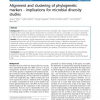148 search results - page 13 / 30 » Inverse Sequence Alignment from Partial Examples |
BMCBI
2010
13 years 8 months ago
2010
Background: Molecular studies of microbial diversity have provided many insights into the bacterial communities inhabiting the human body and the environment. A common first step ...
BMCBI
2004
13 years 8 months ago
2004
Background: For the purposes of finding and aligning noncoding RNA gene- and cis-regulatory elements in multiple-genome datasets, it is useful to be able to derive multi-sequence ...
APAL
2006
13 years 8 months ago
2006
We present a technique for destroying stationary subsets of P+ using partial square sequences. We combine this method with Gitik's poset for changing the cofinality of a cardi...
BMCBI
2006
13 years 8 months ago
2006
Background: Many dimeric protein complexes bind cooperatively to families of bipartite nucleic acid sequence elements, which consist of pairs of conserved half-site sequences sepa...
BMCBI
2010
13 years 8 months ago
2010
Background: Accurate classification into genotypes is critical in understanding evolution of divergent viruses. Here we report a new approach, MuLDAS, which classifies a query seq...

